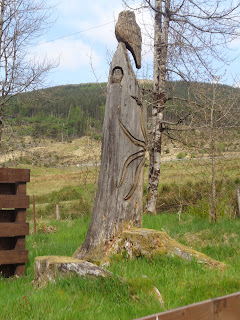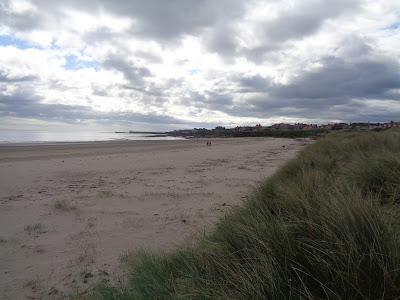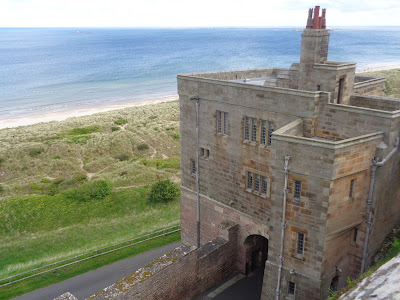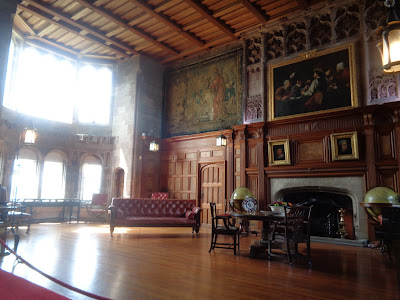On Day 2 on The West Highland Way, we were rather hoping for sunshine as our journey would take us across Rannoch Moor which my guide book, The West Highland Way by Terry Marsh had a rather dire warning about - "In the right conditions, it is quite simply a wonderland, but one that could become a nightmare with any adverse change to the conditions." Given the unpredictability of Scottish weather and the knowledge that if there was a thunderstorm there was absolutely nowhere to shelter I could only hope that the cloudy skies were the worst the day would bring.
We left the Bridge of Orchy village by road, appropriately enough over the stone bridge across the River Orchy which gave the area its name. It was built in 1750 by the British Army following the 1746 Battle of Culloden. Looking back gave us a view of the village nestled in the trees, the last habitation we'd see for several hours.

It is possible to stay on the narrow road until you reach the beginning of Rannoch Moor, an easier walk if you are feeling tired, but as this was only our second day, we had no excuse for not taking the more scenic route.
Fortunately, the path winds mostly around the mountains (or Munros as they are called in Scotland if they are over 3,000 feet) rather than up them, though there is a gentle rise in gradient on this stage of the walk.
Substantial deforestation has taken place in the highlands and we constantly came across areas such as below where the tree stumps and discarded dead limbs create the feeling that you are walking through a tree graveyard.
But the lack of trees does mean that the views stretch on for miles unhindered giving wonderful views of lochs such as Loch Tulla.
Or the path ahead stretching on and on and on into the distance!
A glimpse of civilization in the distance is always a nice reminder that you're on the right path even if it is still a long way off.
Civilization turns out to be the
Inveroran Hotel which looks a delightful place to stay but was not far enough along the route from Bridge of Orchy to justify an overnight stay in our case.
It does have a shop so we were able to stock up on lunch supplies and water. We were going to sit outside and eat but the midgies (swarming small flies which are incredibly annoying and bite) forced us to retreat inside. Midgies are a known Scottish problem in the summer but generally the midgie season is considered to start late May so we'd hoped we'd get our walk in beforehand. The guy serving in the shop told us that this year they'd appeared early. Just our luck.
From the hotel, the path is a well-paved road.
We had been hoping to see some Highland cows on our journey, but had to make do with these guys. Not quite as cute.
Next up was the Forest Lodge, which used to be a hunting lodge but is now apparently owned by the Glencoe Ski Club and rented out in summer months. It looked deserted when we passed by.
Just after the Lodge, the Way follows an old drovers path which crosses Rannoch Moor. We were now at a point at which we were going to be out in the open until we arrived at our overnight stop. The sky was still cloudy but at least they were white clouds.
The crushed stone road was not easy on the feet so whenever possible we stuck to the flattened wheel tracks or the grass verge.
Despite the lack of blue sky which always makes everything look different, the views were still awe-inspiring.
But then the inevitable happened. It started to rain. Luckily we were well prepared. Because there was still a long way to go.
But no sooner had we got the ponchos on, then the rain stopped. I was tempted to keep mine on in an attempt to ward off further downpours but while great for keeping you dry, they do make you rather hot.
Luckily, that was all the rain we had to contend with for the day. A lucky escape! Though still no sun.
We spotted our first snow on the mountains. Still there even in May.
All this landscape. So few people. The sense of solitude is amazing.
Even when you can see others up ahead.
By this point the rocky road was getting quite tiring. I can only imagine what it's like for those who have started the walk from the beginning and are on their fifth or sixth day at this point.
This time our accommodation for the night wasn't a bunk house, but a Pod. My daughter thought it looked like a Hobbit House.
Cozy and private, and with sleeping bags for hire, it was all we needed for the night. There was only the two of us, but there was actually room for four!
There were showers and toilets nearby and, the other essential in Scotland, a drying room. We were thankful we didn't need to use the latter. There is also an on-site cafe serving food and alcohol although it is only open until 8pm in the evening. Still, by that time, after all the fresh air and exercise, a big dinner and a glass of wine, we were ready to call it a day.
Another great day on the walk. (12.4 miles according to my phone.)
For more information about her books visit her website, or sign up for her newsletter.
































































.JPG)

